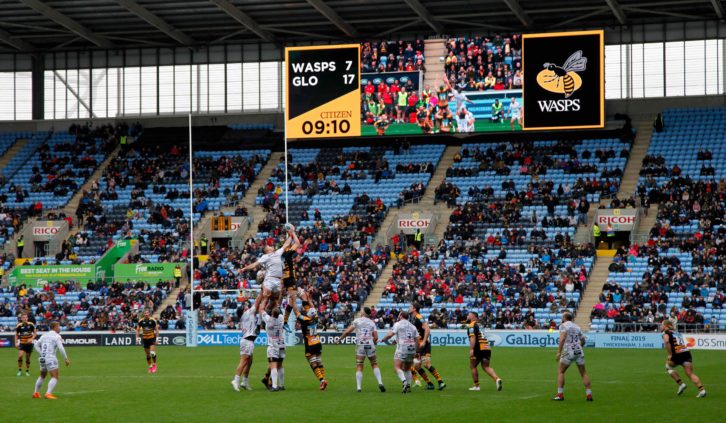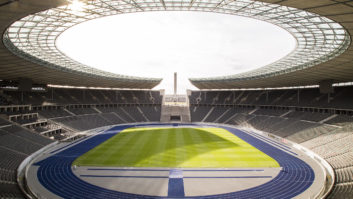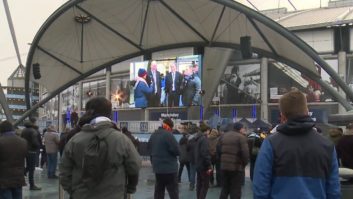If you’re a student of the English language, new words will either delight or appal you. Traditionalists may bemoan what they see as the progressive erosion of how we speak and write – but language must evolve to keep abreast of the new ways in which we live. Take ‘phygital’ for example: the growing crossover between the physical and digital worlds. So-called ‘portmanteau’ words have always been popular to describe our new ways of doing things. Take ‘motel’, ‘docudrama’ and ‘televangelist’. Or even Brangelina.
And now, we have the entirely self-explanatory ‘fantertainment’. Google throws up no fewer than 17,000 links to it. It’s a new way of looking at sport – and the AV industry is at the heart of it. It’s not just about entertainment for the sake of it, though.
Motivators
“In top tier sport, the main motivators behind the growing use of technology – especially screens – are really about enhancing the fan experience by finding more creative ways of engaging with fans through content,” says Daniel Gray, marketing officer, ADI. “Examples might include the delivery of statistics, interactive trivia, or exclusive team content.”
“At the lower tier, the drivers are varied, but usage is perhaps skewed towards commercial revenue,” he continues. “Digital displays are very much used as a commercial asset – an advertising or sponsorship platform that directly drives revenue. Usually we work with clubs to help them create commercial models, which are activated through the use of digital platforms in the stadium.”
There’s more to it, however, than enhancing fan engagement to drive revenues: perception of the status of the club is also at play, believes Ben Kershaw, managing director of Pro Display. “There’s a lot of pressure on venue owners to ensure that their facilities measure up to customers’ and players’ expectations,” he believes. “The impression given of a team, if their stadium is under-equipped, may have a big bearing on the mindset of players and fans.”
Anecdotally, it seems to be the case that football clubs in particular find it easier to sign top flight players if they can offer the lure of playing regularly in a spectacular stadium. Image is everything.
“Stadiums are investing in AV technology in order not only to deliver an enhanced visitor experience, but also to deliver a ‘wow’ factor”
Jasmin Stemmler, NEC Display Solutions Europe
‘Wow!’ factor
“Stadiums are investing in AV technology in order not only to deliver an enhanced visitor experience, but also to deliver a ‘wow’ factor that will lift visitors’ perception of the venue in some way so it must be exciting, inspiring and relevant,” says Jasmin Stemmler, product marketing manager at NEC Display Solutions Europe. She also goes on to note how, just as QSRs are embracing digital signage technology to drive revenues, so too are food and beverage outlets in stadia – and how screens can be used to publicise events that might otherwise slip under the radar of their prospective audience.”
Displays have long been a feature of world class stadia – but, historically, those were enormous, LED-based screens (Sony’s JumboTron was the earliest example) that delivered basic in-game information. What’s new isn’t the use of displays – it’s the proliferation, and how they’re used.
“Screens are a tool to keep fans engaged and entertained wherever they are in the stadium,” believes Andy Truswell, systems integration manager, Pure Audio Visual. “If they need to leave the match area, live streamed footage means nothing is missed. Pre- and post-match they inform, promote and entertain. They have the potential to assist with visitor flow and evacuation management. In some venues, they support in-house advertising and are used to promote the additional facilities available to fans and visitors to the stadium.”
Connected stadium
“Displays today are being used in more of a variety of different ways than ever before,” says Mark Childerhouse, director, Pioneer Group, “from wayfinding and live match updates, to bespoke content, digital menu boards, to essential messaging and advertising. The idea of a connected stadium is just emerging as a reality, with rapid deployment of content across displays on concourse, on the pitch, in hospitality areas and in the bars and restaurants.”
“There is a growing demand for displays outside of the main bowl,” echoes Ewan Prentice, business development manager at Daktronics. “To create an experience that cannot be replicated by the home experience, fans need to be engaged from the moment they arrive at the facility. Uniquely shaped marquee displays, transparent displays, high-resolution indoor displays in clubs, atriums or concourses are all growing in popularity to keep fans engaged and immersed in the excitement of the event before, during, and after the match.
“What started as a need to show live video, replays and advertising has evolved into needing better image quality, larger sizes for better visibility and an increased amount of signage to accommodate multiple needs,” he goes on. “The control systems have required advancement as the display technology has evolved to better accommodate the amount of pixels on a display as well as the number of displays they are controlling. A truly integrated system to create a fully-immersive fan experience is becoming the expectation.”

Case study: Wasps fly high with ADI
The Ricoh Arena in Coventry is home to Wasps, one of England’s top rugby union clubs (and, until the end of last season, to League One club Coventry City). ADI installed a 188sqm LED screen at the stadium as part of a wider installation that includes scoreboard, external screens and internal foyer displays. ADI also manages all the content.
Because the screen is a superwide format, Wasps can use the canvas much more creatively – combining content to engage and inform fans on a match day. The display can be split into zones, delivering live clock and score, alongside club partner branding – all without detracting from the main video window relaying the match action.
Social media is a big part of the match day experience, with fan tweets occupying a section of the screen. According to ADI, Wasps have seen a significant increase in fan engagement since installation.
www.adi.tv
www.daktronics.com
www.nec-display-solutions.com
www.pioneergroup.co.uk
www.prodisplay.com
www.pureav.co.uk







